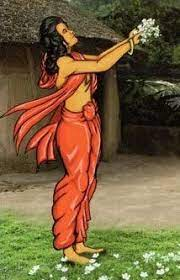Some of the occupants of the throne were themselves scholars. This can be understood by knowing the legacy of some royal people. One among such of them the author of JanakiHaranam is identified with King Kumaradasa of Cylon. Kumaradasa also called Kumara Dhatusena was a king of Anuradhapura, Cylone in the 6th Century A.D., whose reign lasted from 515 to 524. He succeeded his father Moggallana I as king of Anuradhapura and was succeeded by his son Kittisena.
Jānakīharaṇam written by Kumāradāsa is one among the
earlier Mahā-kāvyas in Sanskrit literature. It consists of 20
Cantos. He was born blind and was helped
in getting his kingdom and in writing this poem by his two maternal uncles. The colophons of the manuscripts to each canto
mention the Sinhalese nativity of the poet:- “Iti simhalakaveh Kumara-dasasya
krtau Janakiharane mahakavye …… sargah”. It is to be noted that the Trivandrum
transcript has at the end of the poem a small verse in the form of phalaśruti which runs thus, “Janakiharanam
slakshnam lakshanairupalkshitam, Ramayanasudhasaram asvadyam mukti-dayakam”.
Alaṅkāra
writers like Hemacandra (1089 to 1173 A.D.), and Bhoja (1010 TO
1055 A.D.) also quote from Kumāradāsa’s work.
Next comes the important author, Rājaśekhara of C. 900 A.D., who
makes some references to Kumāradāsa. In
his Kāvyamīmāmsā he refers to the poet as born blind. He has also left a verse on Kumāradāsa and his poem:-
“Janakiharanam kartum Raghuvamse sthite sati, Kavih Kumaradasasca
Ravanascayadi kshamah” means, “To have produced
an Abduction of Sita, When
the Dynasty of Raghu was present before him-“One must have been Kumāradāsa or
else been Rāvaṇa”. Though there are different opinions
on the date of Kumāradāsa, many Sanskrit scholars accepted to assign
Kumāradāsa here to the beginning of the 6th Century.
Kumāradāsa was a great poet with
innate literary talents. He was quite at
ease in handling chaste words of exquisite beauty. His utterances suit the occasion even by
their mere sound effect.





No comments:
Post a Comment